
HISTORICAL BACKGROUND...
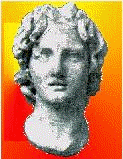 Daily rhythms in plants and
animals have been noticed since early times. As early as the fourth century
B.C., Alexander the Great's scribe Androsthenes noted that the leaves of
certain trees opened during the day and closed at night.
Daily rhythms in plants and
animals have been noticed since early times. As early as the fourth century
B.C., Alexander the Great's scribe Androsthenes noted that the leaves of
certain trees opened during the day and closed at night.
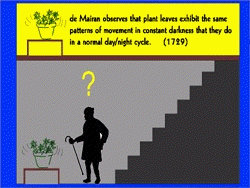 In 1729, French astronomer Jean Jacques d'Ortous deMairan conducted the
first known experiment on biological
rhythms. He noticed that his heliotrope
plant's leaves opened during the day and folded at night. When he put the
plant in total darkness, the rhythm continued, however,
In 1729, French astronomer Jean Jacques d'Ortous deMairan conducted the
first known experiment on biological
rhythms. He noticed that his heliotrope
plant's leaves opened during the day and folded at night. When he put the
plant in total darkness, the rhythm continued, however,
 and was not disrupted by the
absence of daylight as an environmental cue. Although he was interested in
this botanical phenomenon, deMairan pursued astronomy instead.
and was not disrupted by the
absence of daylight as an environmental cue. Although he was interested in
this botanical phenomenon, deMairan pursued astronomy instead.
Two centuries before modern gardeners noticed that their day lilies closed at
night, the famous taxonomist Carolus Linnaeus discovered that the petals
of many flower species opened and closed at regular times. He even created a
garden with flowers which opened at various times so that he could tell the
time of day by looking in his garden.
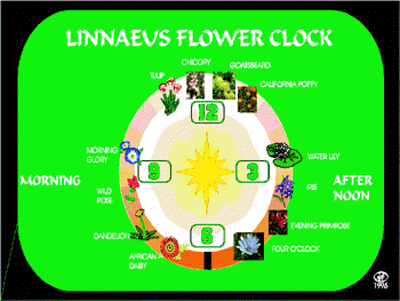
Nothing exciting happened for many years...
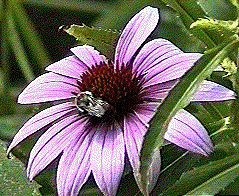 until the early 1900's, when
Karl von Frisch observed that bees visited
flowers only at specific times. He and Ingeborg Beling trained bees to
visit a nectar feeding station between 4 and 6 PM . The bees did not visit
at other times, and they still visited even when the nectar was removed. When
outside cues such as light were removed in laboratory trials, the bees still
fed at prescribed times. Although von Frisch did not know it, the bees were
operating on an internal clock.
until the early 1900's, when
Karl von Frisch observed that bees visited
flowers only at specific times. He and Ingeborg Beling trained bees to
visit a nectar feeding station between 4 and 6 PM . The bees did not visit
at other times, and they still visited even when the nectar was removed. When
outside cues such as light were removed in laboratory trials, the bees still
fed at prescribed times. Although von Frisch did not know it, the bees were
operating on an internal clock.
It wasn't until the 1950's that Gustav
Kramer and Klaus Hoffmann proved the
existence of a biological clock.
With an ingenious apparatus, Kramer demonstrated that starlings used the sun
as a compass to migrate even though the sun itself moves throughout the day.
That is, the bird's internal clock reorients it in the direction of the moving
sun. Hoffmann showed that the clock persisted in dim light and thus is
endogenous to the animal. He showed
that the animal's clock was synchronized to local time by the influence of the
local environment.
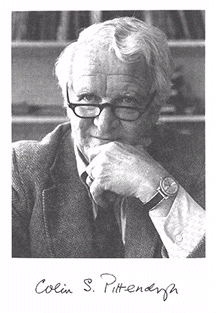 In the 1950's,
Colin Pittendrigh demonstrated that
circadian clocks are temperature
compensated (have nearly the same period
even when the temperature changes). Most metabolic activities increase when
body temperature increases, but the period of the biological clock does not.
Pittendrigh placed Drosophila pseudoobscura cultures at different
temperatures and recorded the time of eclosion.
Even in constant darkness, the flies emerged on schedule regardless of the
temperature. Temperature changes thus did not affect the period of the
clock [1].
In the 1950's,
Colin Pittendrigh demonstrated that
circadian clocks are temperature
compensated (have nearly the same period
even when the temperature changes). Most metabolic activities increase when
body temperature increases, but the period of the biological clock does not.
Pittendrigh placed Drosophila pseudoobscura cultures at different
temperatures and recorded the time of eclosion.
Even in constant darkness, the flies emerged on schedule regardless of the
temperature. Temperature changes thus did not affect the period of the
clock [1].

Reproduced, with permission, from the Annual Review of Physiology, Volume 55, Copy. 1993, by Annual Reviews Inc.
Accessibility statement
 In 1729, French astronomer Jean Jacques d'Ortous deMairan conducted the
first known experiment on biological
rhythms. He noticed that his heliotrope
plant's leaves opened during the day and folded at night. When he put the
plant in total darkness, the rhythm continued, however,
In 1729, French astronomer Jean Jacques d'Ortous deMairan conducted the
first known experiment on biological
rhythms. He noticed that his heliotrope
plant's leaves opened during the day and folded at night. When he put the
plant in total darkness, the rhythm continued, however,

 Daily rhythms in plants and
animals have been noticed since early times. As early as the fourth century
B.C., Alexander the Great's scribe Androsthenes noted that the leaves of
certain trees opened during the day and closed at night.
Daily rhythms in plants and
animals have been noticed since early times. As early as the fourth century
B.C., Alexander the Great's scribe Androsthenes noted that the leaves of
certain trees opened during the day and closed at night. 
 until the early 1900's, when
until the early 1900's, when
 In the 1950's,
In the 1950's,